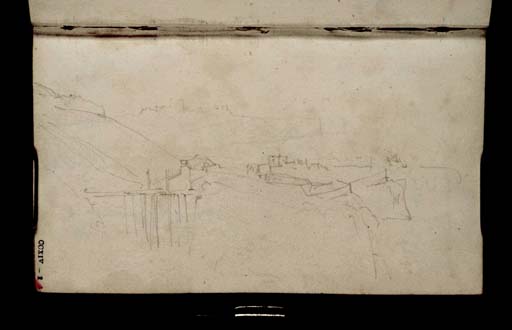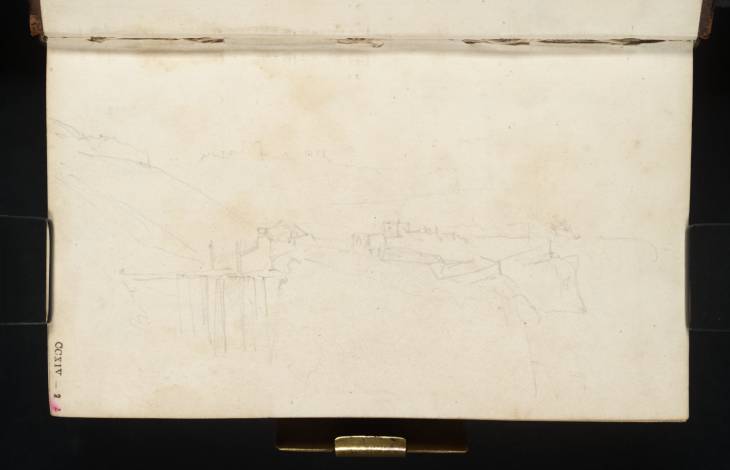Joseph Mallord William Turner Dover from the Fortifications on the Western Heights, with the Castle above the Harbour in the Distance 1825
Image 1 of 2
-
 Joseph Mallord William Turner, Dover from the Fortifications on the Western Heights, with the Castle above the Harbour in the Distance 1825
Joseph Mallord William Turner, Dover from the Fortifications on the Western Heights, with the Castle above the Harbour in the Distance 1825 -
 Joseph Mallord William Turner, Dover from the Fortifications on the Western Heights, with the Castle above the Harbour in the Distance 1825 (Enhanced image)Enhanced image
Joseph Mallord William Turner, Dover from the Fortifications on the Western Heights, with the Castle above the Harbour in the Distance 1825 (Enhanced image)Enhanced image
Joseph Mallord William Turner,
Dover from the Fortifications on the Western Heights, with the Castle above the Harbour in the Distance
1825
Joseph Mallord William Turner 1775–1851
Folio 2 Recto:
Dover from the Fortifications on the Western Heights, with the Castle above the Harbour in the Distance 1825
D18843
Turner Bequest CCXIV 2
Turner Bequest CCXIV 2
Pencil on white wove paper, 95 x 155 mm
Inscribed by John Ruskin in red ink ‘2’ bottom left, descending vertically
Stamped in black ‘CCXIV – 2’ bottom left, descending vertically
Inscribed by John Ruskin in red ink ‘2’ bottom left, descending vertically
Stamped in black ‘CCXIV – 2’ bottom left, descending vertically
Accepted by the nation as part of the Turner Bequest 1856
References
1909
A.J. Finberg, A Complete Inventory of the Drawings of the Turner Bequest, London 1909, vol.II, p.650, CCXIV 2, as ‘View at Dover’.
1981
Eric Shanes, Turner’s Rivers, Harbours and Coasts, London 1981, p.153.
With the page turned horizontally, the view is north-east to the faint outlines of Dover Castle and the cliffs towards the South Foreland. In the foreground, on the slopes above the harbour and the English Channel, is part of the extensive Napoleonic defences on the Western Heights. Its various deep, brick-lined dry ditches, long abandoned for military purposes but accessible by footpaths, are today partly under the care of English Heritage.1 Eric Shanes has linked this page2 to a watercolour (currently untraced),3 engraved in 1826 for the Picturesque Views on the Southern Coast of England as Dover from Shakespeare’s Cliff (Tate impressions: T04424, T05246–T05251, T06000); see the sketchbook’s Introduction for the project and drawings on adjacent pages for other Southern Coast Kent subjects.
The present sketch provided the overall composition, which Shanes has described as a ‘synthesis’, informed by details introduced from studies of the castle and the cliffs beyond it on folios 256 verso, 257 verso, 265 verso, 268 verso, 269 recto and 271 recto (D19349, D19351, D19367, D19373–D19374, D19378).4 See also the views from Shakespeare Cliff itself on folios 266 recto and verso (D19368–D19369). The empty foreground here was enlivened in the finished design by a sentry overlooking the chasm and the sea, with a cart and horses crossing the precipitous bridge, while smoke from gunnery practice billowing over the beach below implied the site’s continued importance in the defence of the nation ten years and more after the defeat of the French.5
There are extensive sketches and detailed studies around Dover, including further aspects of the Western Heights, the castle, harbour and cliffs, at both ends of this sketchbook; see also folios 1 recto and verso, the verso of the present page, folios 3 recto–7 recto, and 253 verso–272 verso (D18841–D18842, D18844–D18853, D19343–D19381). For views in the contemporary Holland, Meuse and Cologne sketchbook, see under Tate D19401 (Turner Bequest CCXV 1). Although many of these studies show the castle and cliffs from various points immediately around the harbour, Turner was precluded from using such a viewpoint for his Southern Coast design by Samuel Owen’s Dover Castle, Kent, published in the same series in 1814 (Tate impressions: T05242–T05243).
Turner’s ongoing engagement with Dover in terms of sketches and finished watercolours, as a dramatic subject in itself (which it remains despite much development) and as a gateway to the Continent, extended from the early 1790s through to the last years of his active career. See also the following Tate sketchbooks: Small Calais Pier, 1802; Hastings, c.1816–18; Richmond Hill; Hastings to Margate, c.1816–19; Remarks (Italy), 1820; Folkestone, c.1821–2; Paris, Seine and Dieppe, 1821; Ports of England, c.1822–3; Cowes Regatta, 1827; Roman and French Notebook, 1828; Würzburg, Rhine and Ostend, 1840; Dover, Rhine and Innsbruck, 1843; and 1845’s Near Folkestone (?) and Dieppe and Kent (Turner Bequest LXXI, CXXXIX, CXL, CXCIII, CXCVIII, CCXI, CCII, CCVII, CCXXXVII, CCCIII, CCCIX, CCCLIV, CCCLXI).
For other detailed accounts in the present catalogue, see Andrew Wilton’s ‘Dover 1793’ within his ‘London and Home Counties 1793–5’ section, and Alice Rylance-Watson’s entry for the contemporary Ports of England watercolour Dover (Tate D18154; Turner Bequest CCVIII U),6 engraved in 1827 (Tate impressions: T04828–T04829). Shanes linked that design in turn to folios 256 verso and 272 verso of this book (D19349, D19381).7
Matthew Imms
September 2020
See ‘Western Heights, Dover’, English Heritage, accessed 25 February 2020, https://www.english-heritage.org.uk/visit/places/western-heights-dover/ .
How to cite
Matthew Imms, ‘Dover from the Fortifications on the Western Heights, with the Castle above the Harbour in the Distance 1825 by Joseph Mallord William Turner’, catalogue entry, September 2020, in David Blayney Brown (ed.), J.M.W. Turner: Sketchbooks, Drawings and Watercolours, Tate Research Publication, March 2023, https://www

